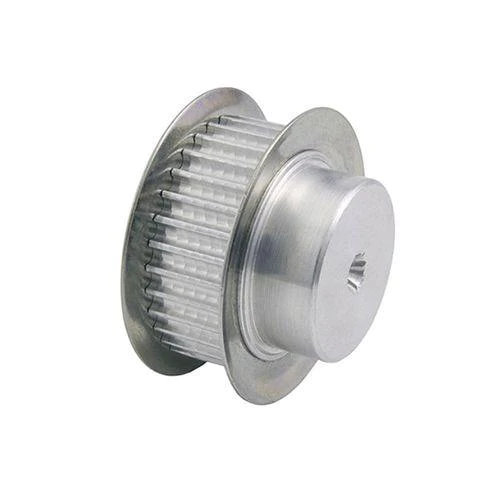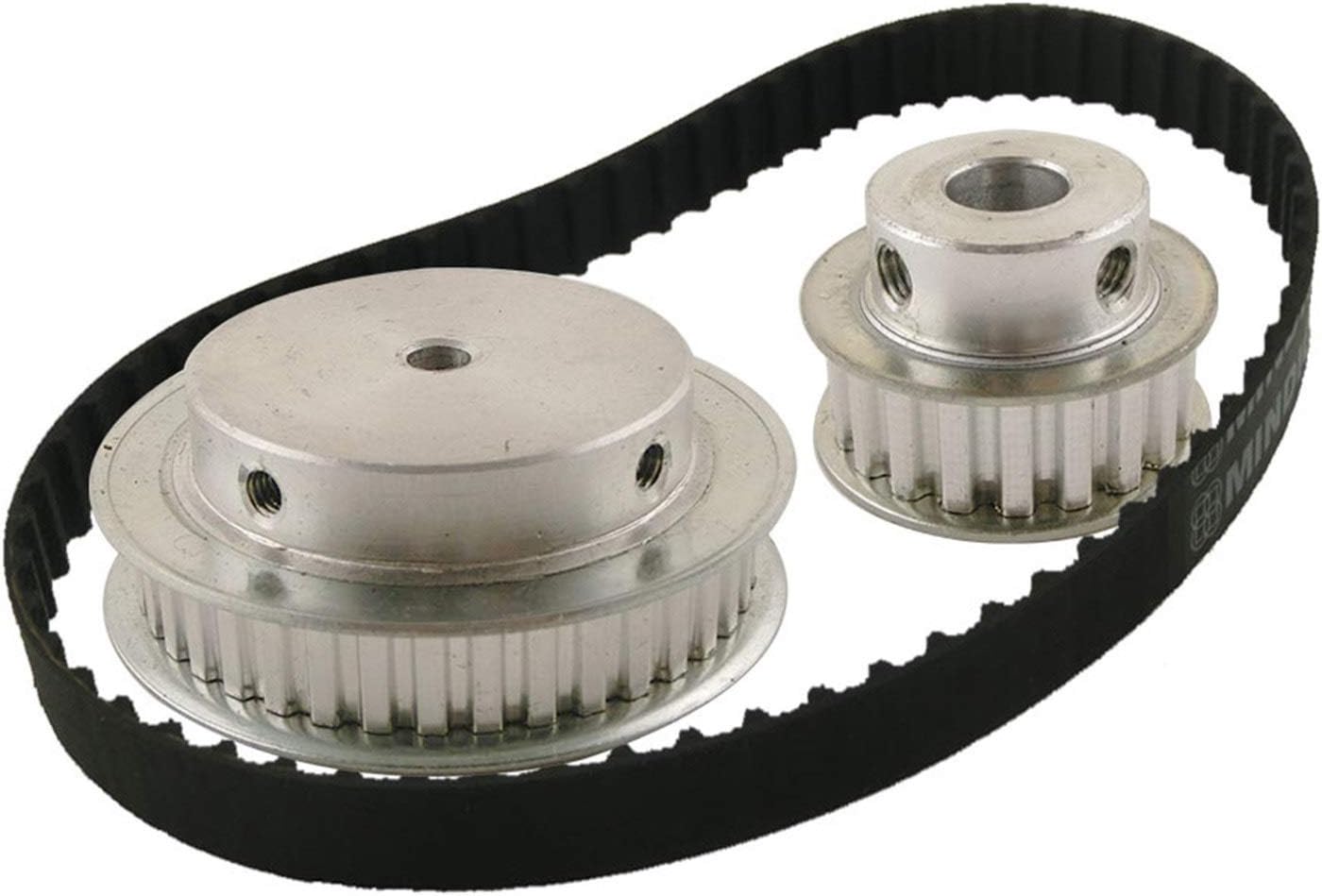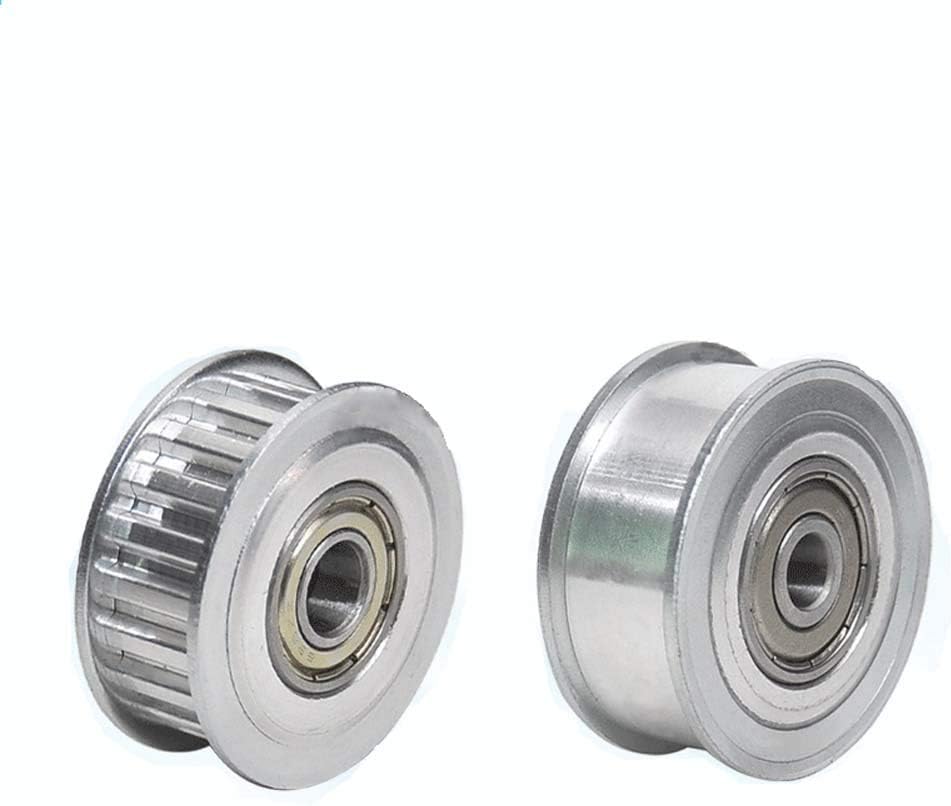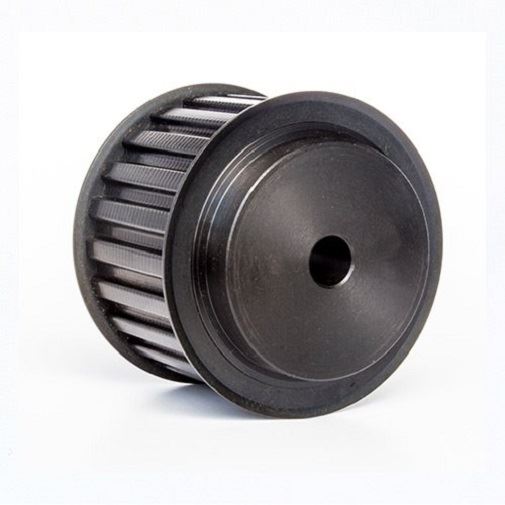Product Description
Aluminium Conveyor Timing Belt Pulley With MXL XL L H
Rely on the driving wheel to push the driven wheel in turn to transmit the movement and power between the 2 shafts. Due to the characteristics of wheels
1. Mesh transmission, accurate transmission ratio, stable transmission and low noise.
2. Wide range of power and speed.
3. High efficiency, long service life, safe and reliable work.
4. The cost is not very high, and special equipment is required for processing.
Product Parameters
| Product | standard timing belt pulley & idler pulley |
| Customized | OEM, drawings or samples customized |
| Teeth type | Normal Torque Drive Type:MXL,XL,L,H,XH,XXH High Torque Drive Type:S2M,S3M,S5M,S8M,HTD2M,HTD3M,HTD5M,HTD8M,P2M,P3M,P5M,P8M High Precision Position Drive Type:2GT,3GT,5GT,8YU Light Load Drive Type:T5,T10,T20 Heavy Load Drive Type:AT5,AT10,AT20 |
| Basic shape | Type A,Type B,Type D,Type E,Type F,Type K |
| Adaption | Adapt to 1/4 inch,5/16 inch,1/2 inch, 3/8inch, 2/25inch, 1/5inch belt |
| surface treatment | Natural color anodizing,Black anodizing,Hard anodizing,Ni-plating,Blackening |
| Material | 6061(aluminum),S45C(45# steel),SUS304(Stainless steel) |
| Bore | Pilot bore, Taper bore and Customized bore. |
| Tolerance Control | Outer diameter ±0.005mm Length dimension ±0.05mm |
| Standard | DIN, ISO/GB, AGMA, JIS |
| Teeth Accuracy | DIN Class 4, ISO/GB Classs 4, AGMA Class 13, JIS Class 0 |
| Weight | Max 15Tons |
| testing equipment | projecting apparatus,salt spray test,durometer,and coating thickness tester,2D projector |
| producing equipment | CNC machine,automatic lathe machine,stamping machine,CNC milling machine,rolling machine,lasering,tag grinding machine etc. |
| Machining Process | Gear Hobbing, Gear Milling, Gear Shaping, Gear Broaching,Gear Shaving, Gear Grinding and Gear Lapping |
| Application industry | Robot industry,Medical industry,Making machine industry,Automation industry,3C industry equipment,Packaging industry,UAV industry,New energy industry. |
Company Profile
Packaging & Shipping
1. Lead time: 10-15 working days as usual, 30 days in busy season, it will based on the detailed order quantity;
2. Delivery of samples: by DHL, Fedex, UPS, TNT, EMS
FAQ
| Main markets | Southeast Asia, North America, Eastern Europe, Mid-East, West Europe |
| How to order | *You send us drawing or sample |
| *We carry through project assessment | |
| *We give you our design for your confirmation | |
| *We make the sample and send it to you after you confirmed our design | |
| *You confirm the sample then place an order and pay us 30% deposit | |
| *We start producing | |
| *When the goods is done,you pay us the balance after you confirmed pictures or tracking numbers | |
| *Trade is done,thank you! |
/* January 22, 2571 19:08:37 */!function(){function s(e,r){var a,o={};try{e&&e.split(“,”).forEach(function(e,t){e&&(a=e.match(/(.*?):(.*)$/))&&1
| Certification: | CE, ISO |
|---|---|
| Pulley Sizes: | Timing |
| Manufacturing Process: | Cutting |
| Material: | 6061, S45 |
| Surface Treatment: | Polishing |
| Application: | Machinery Parts |
| Customization: |
Available
| Customized Request |
|---|
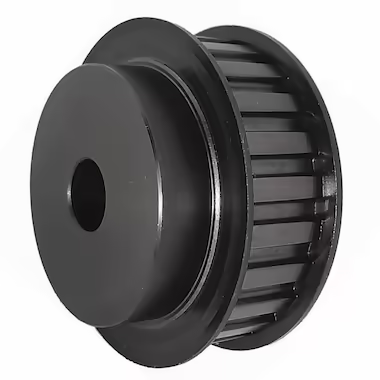
How do XL pulleys compare to other pulley types, such as HTD or V-belt pulleys?
XL pulleys, HTD pulleys, and V-belt pulleys are all popular types of pulleys used in mechanical systems. Here is a detailed comparison of XL pulleys with HTD and V-belt pulleys:
1. Tooth Profile:
XL pulleys and HTD (High Torque Drive) pulleys both utilize toothed belts for power transmission. The main difference lies in their tooth profiles. XL pulleys have trapezoidal teeth, while HTD pulleys have a curvilinear tooth profile. V-belt pulleys, on the other hand, are designed for V-belts, which have a wider, wedge-shaped cross-section.
2. Power Transmission Capacity:
XL pulleys and HTD pulleys offer higher power transmission capacities compared to V-belt pulleys. The toothed belt designs of XL and HTD pulleys provide a positive engagement, preventing slippage under higher loads or torque. V-belt pulleys rely on friction between the belt and pulley, limiting their power transmission capacity.
3. Speed Capability:
XL pulleys and HTD pulleys are both suitable for higher speed applications compared to V-belt pulleys. The toothed belt designs allow for better grip and reduced belt slippage, enabling XL and HTD pulleys to operate at higher rotational speeds without compromising performance. V-belt pulleys are generally suitable for lower speed applications.
4. Efficiency:
XL pulleys and HTD pulleys offer higher efficiency compared to V-belt pulleys. The positive engagement between the toothed belts and pulleys in XL and HTD systems minimizes slippage and associated energy losses. V-belt pulleys, relying on friction, may experience higher energy losses due to belt slip.
5. Precision and Positioning:
XL pulleys and HTD pulleys provide better positional accuracy and reduced backlash compared to V-belt pulleys. The toothed belt systems offer improved control and synchronization, making them suitable for applications that require precise positioning or timing, such as robotics or CNC machines.
6. Noise and Vibration:
XL pulleys and HTD pulleys generally produce less noise and vibration compared to V-belt pulleys. The toothed belt systems exhibit smoother operation due to their positive engagement, reducing noise and vibration levels. V-belt pulleys may generate more noise and vibration due to potential slippage and belt oscillation.
7. Installation and Maintenance:
XL pulleys, HTD pulleys, and V-belt pulleys are all relatively easy to install and maintain. However, V-belt pulleys may require more frequent tension adjustments and periodic belt replacements due to belt wear and stretch. Toothed belt systems, including XL and HTD pulleys, often require less maintenance and offer longer belt life.
8. Application Suitability:
The choice between XL pulleys, HTD pulleys, and V-belt pulleys depends on the specific application requirements. XL and HTD pulleys are commonly used in industrial automation, power transmission, and precision machinery applications that demand higher torque, speed, and accuracy. V-belt pulleys are often employed in applications such as HVAC systems, automotive engines, and smaller machinery.
In summary, XL pulleys, HTD pulleys, and V-belt pulleys have differences in tooth profile, power transmission capacity, speed capability, efficiency, precision, noise/vibration levels, installation/maintenance, and application suitability. Understanding these differences is crucial in selecting the most appropriate pulley type for a given mechanical system and its specific requirements.
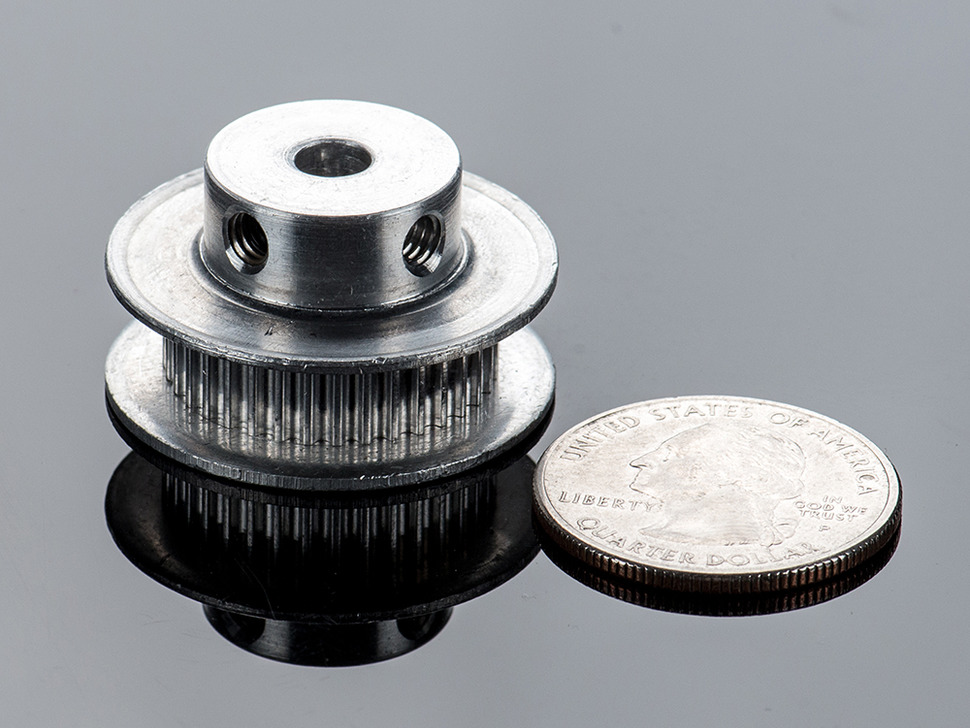
How do advancements in material technology influence the design of modern XL pulleys?
Advancements in material technology have a significant impact on the design of modern XL pulleys. Here’s a detailed explanation of how these advancements influence their design:
1. Enhanced Durability:
New materials with improved strength and durability allow for the design of XL pulleys that can withstand higher loads, operate at higher speeds, and have increased resistance to wear and fatigue. Advanced materials, such as high-strength alloys, composites, or specialized polymers, provide superior mechanical properties, enabling the design of more robust and long-lasting pulleys.
2. Weight Reduction:
Lightweight materials, such as carbon fiber composites or engineered polymers, contribute to the design of lightweight XL pulleys. Reduced weight in pulley systems offers advantages such as improved energy efficiency, reduced inertia, and lower overall system weight. This is particularly beneficial in applications where weight reduction is critical, such as aerospace, automotive, or portable machinery.
3. Corrosion Resistance:
New materials with excellent corrosion resistance properties, such as stainless steel or corrosion-resistant coatings, enable the design of XL pulleys suitable for harsh or corrosive environments. Corrosion-resistant pulleys are essential in industries such as marine, chemical processing, or outdoor applications where exposure to moisture, chemicals, or saltwater can cause degradation and premature failure.
4. Temperature Resistance:
Advancements in material technology have led to the development of materials that can withstand extreme temperatures. For applications involving high or low temperature environments, such as industrial ovens, furnaces, or cryogenic systems, the use of materials with superior temperature resistance ensures the pulleys maintain their performance and integrity under challenging operating conditions.
5. Noise and Vibration Damping:
New materials with inherent damping properties, such as elastomers or composite laminates, contribute to the design of XL pulleys that can effectively reduce noise and vibrations during operation. This is particularly important in applications that require low noise levels or where excessive vibrations can affect the performance and reliability of the system.
6. Customization and Flexibility:
Advancements in material technology provide designers with a wider range of options to tailor the properties of XL pulleys to specific application requirements. Materials can be formulated or engineered to meet specific needs such as high friction coefficients, electrical conductivity, or resistance to specific chemicals. This customization and flexibility in material selection allow for the optimization of pulley design and performance for various applications.
Overall, advancements in material technology have revolutionized the design of modern XL pulleys by offering improved durability, reduced weight, corrosion resistance, temperature resistance, noise and vibration damping, and customization options. Manufacturers can leverage these advancements to develop pulleys that meet the evolving needs of diverse industries and deliver enhanced performance and reliability.
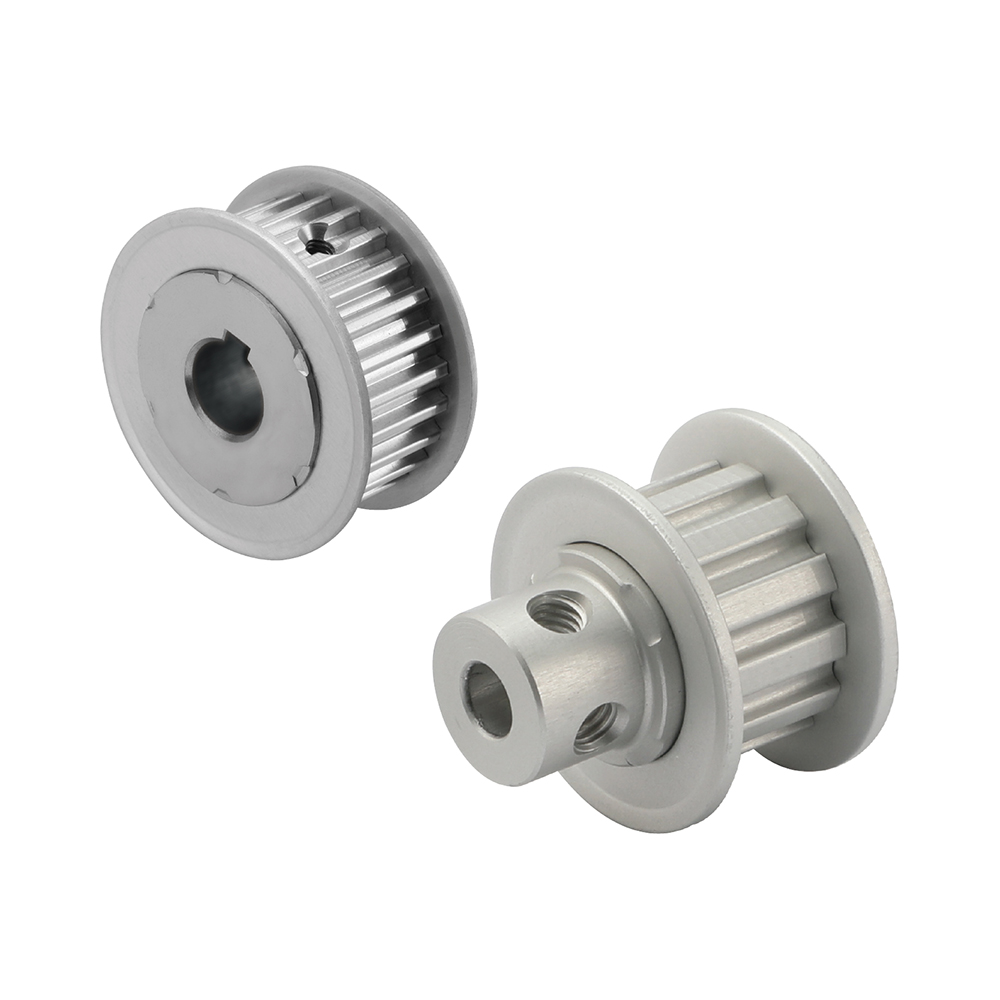
How do XL pulleys enhance the precision and efficiency of mechanical systems?
XL pulleys play a crucial role in enhancing the precision and efficiency of mechanical systems by providing precise motion control and efficient power transmission. Here are the key ways in which XL pulleys contribute to the improvement of mechanical systems:
1. Accurate Motion Control:
XL pulleys, when used in conjunction with timing belts, enable accurate and synchronized motion control. The tooth profile of XL pulleys is designed to match the tooth profile of the timing belt, ensuring precise engagement and motion transfer. This accuracy in motion control allows mechanical systems to achieve precise positioning, movement, and coordination of components.
2. Positioning Accuracy:
By providing precise motion control, XL pulleys contribute to positioning accuracy in mechanical systems. Whether it’s a robotic arm, a CNC machine tool, or a 3D printer, the precise movement enabled by XL pulleys ensures that components or tools are positioned with high accuracy, resulting in the desired output or product quality.
3. Repeatability:
XL pulleys facilitate consistent and repeatable motion in mechanical systems. The accurate engagement between the pulleys and timing belts ensures that the same motion is reproduced reliably each time. This repeatability is essential in applications where consistent results are required, such as in manufacturing processes or automated systems.
4. Reduced Backlash:
Backlash refers to the undesired clearance or play between mating components, which can cause inaccuracies and imprecise motion. XL pulleys, with their precise tooth engagement with timing belts, minimize backlash in mechanical systems. This reduction in backlash improves the overall precision and eliminates unwanted movement or positioning errors.
5. Efficiency in Power Transmission:
XL pulleys, when combined with properly sized timing belts, offer efficient power transmission in mechanical systems. The toothed nature of the pulleys and belts allows for high torque transfer, minimizing slippage and ensuring reliable power delivery. This efficiency in power transmission maximizes the utilization of energy and reduces energy losses, resulting in improved overall system efficiency.
6. Interchangeability and Flexibility:
XL pulleys adhere to standardized dimensions and tooth profiles, allowing for interchangeability between different manufacturers. This interchangeability provides flexibility in system design, maintenance, and upgrades. It also simplifies the replacement of pulleys, which can be beneficial in minimizing downtime and reducing costs.
7. Load Handling Capability:
XL pulleys are designed to handle moderate to high torque requirements. This load handling capability makes them suitable for various applications that require robust and reliable power transmission, such as in heavy machinery, automation systems, or industrial equipment.
By enhancing precision in motion control, improving efficiency in power transmission, and offering flexibility in system design, XL pulleys contribute to the overall performance and reliability of mechanical systems. They enable accurate positioning, repeatable motion, and efficient energy transfer, leading to improved productivity, quality, and operational efficiency.


editor by CX
2024-05-16
